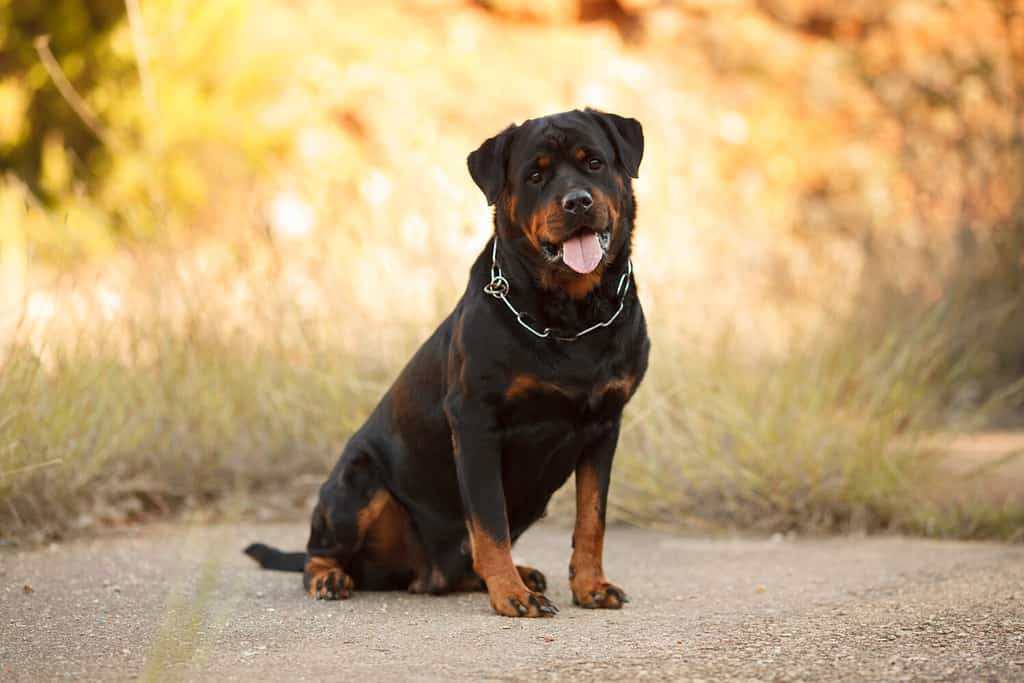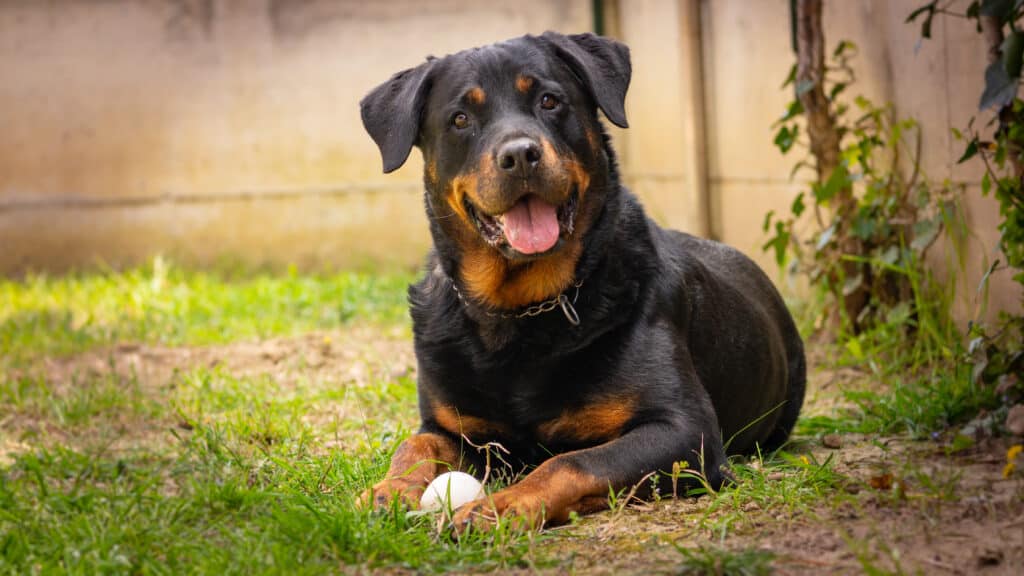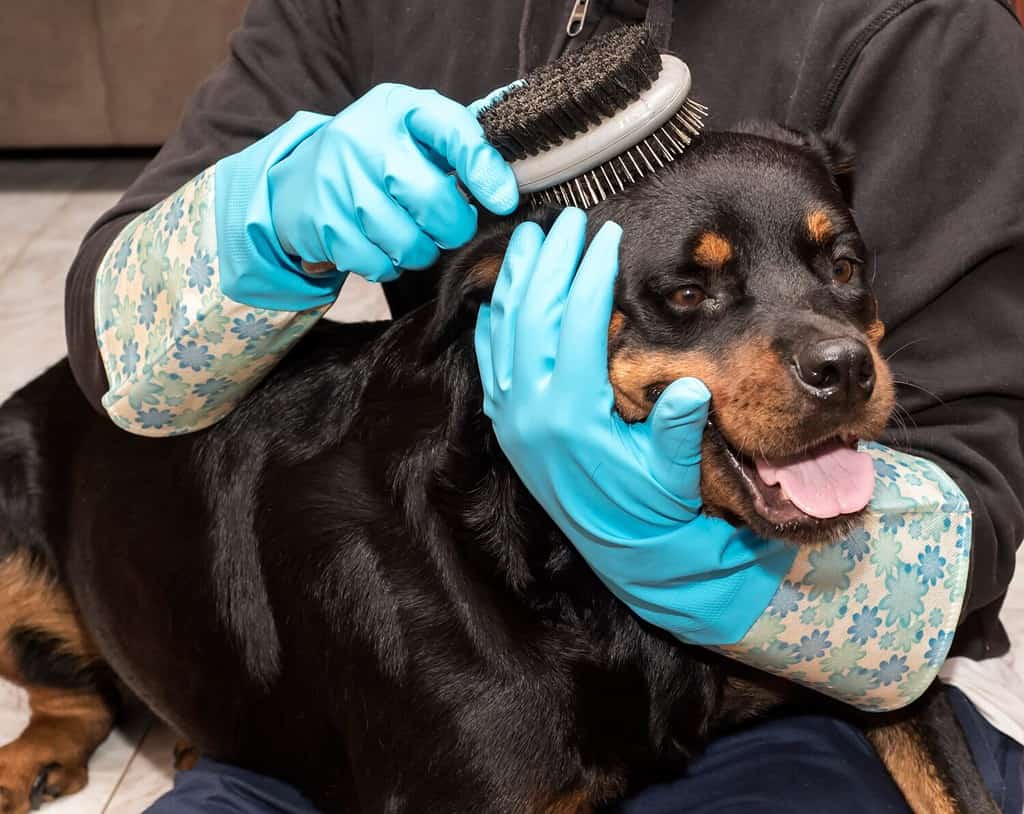One of the world’s most intelligent breeds and loyal dogs, the Rottweiler (Canis lupus) is a favorite in many households. Initially called butcher dogs, Rottweilers’ job used to be herding livestock and pulling carts. Today, Rottweielrs are service dogs, police dogs, search and rescue dogs, and guard dogs for the home. They are known to be loyal, protective, and highly intelligent dogs.
Many people buy a Rottweiler for their home as protection for their family, but when purchasing, a common question arises. Which gender should I get? While both male and female Rottweilers are incredible companions for the home, there are some critical differences between them. This article will tackle the ten key differences between male and female Rottweilers and provide data to help you better decide which gender suits your family.

According to the
American Kennel Club, Rottweilers are the world’s eighth most popular dog breed.
©Serova_Ekaterina/Shutterstock.com
Comparing a Male and Female Rottweiler
| Category | Male | Female |
|---|---|---|
| Size | 24-27 inches 110-132 pounds | 22-25 inches 77-105 pounds |
| Physical Traits | More massive Larger frame Heavier bones | Less massive Smaller frame Distinctly feminine |
| Reproduction | Responsible for fertilization Capable of breeding year-round Can be used for reproduction by age two | Carries pup to term Only receptive to mating when in heat. The first heat is around eight months, but do not breed until 18 months. |
| Health | Average 8-10 year life span Prone to many health issues More prone to skin conditions than females | Average 8-10 year life span Usually live slightly longer than males Prone to many health issues |
| Temperament | Playful puppies Aggressive tendencies Alpha temperament | More docile Protective tendencies Calm temperament |
| Training | Highly intelligent High confidence | Highly intelligent Desire to please |
| Guard Dogs | More aggressive More alert | More attached to the family Very protective |
| Relationship with Children | Very playful Can have accidental injuries | Docile Use motherly instincts to protect |
| Relationship with Other Dogs | Is good as long as properly trained Can be aggressive if not neutered | Is good as long as properly trained Usually docile |
| Relationship with Other Pets | Good with regular socialization and training | Good with regular socialization and training |
Key Differences Between a Male and Female Rottweiler
The key differences between a male and female Rottweiler are their size and physical traits, roles in reproduction and health concerns, temperament, and relationship with other dogs and people.
While male and female Rottweilers may look similar and are both beautiful dogs, they have some key differences. While some differences may be more pronounced — like their distinct roles in reproduction — others may be harder to identify. Let’s explore the key differences between male and female Rottweilers.

Rottweilers are thought to be one of the oldest breeds.
©nicolas.fontana/Shutterstock.com
1. Male vs. Female Rottweiler: Size Differences
Rottweilers are considered a medium to large breed of dog. While both males and females are seen as large, there is a size difference in their height and weight. Male Rottweilers average between 24-27 inches, whereas females average between 22-25 inches. Additionally, males weigh between 110-132 pounds, and females average 77-105 pounds.
Although both genders of this breed are considered significant in size, the males are larger than the females in length and weight.
2. Male vs. Female Rottweiler: Physical Differences
In addition to their length and weight, a few other distinguishing physical features set the male and female Rottweilers apart. While both genders share the same general build — robust — and coloring —black with defined rust markings — their body structures vary slightly. Males are more massive than females and sport a larger frame and heavier bones. Females are distinctly feminine in appearance but do not sacrifice their strength.
Both genders feature the same compact build that allows them to showcase their strength, agility, and endurance. In addition, both feature the same color — such as russet colors above the eyes and inside rear legs — and coat type. Rottweilers feature a shorter outer coat with dense, medium-length hair.
Although similar in many ways, the two genders can be distinguished by the male’s more prominent and dense frame.
3. Male vs. Female Rottweiler: Reproduction

Rottweiler puppies are adorable and also very needy. Rottweilers, especially puppies, may experience separation anxiety.
©Rita_Kochmarjova/Shutterstock.com
The main difference between the male and female Rottweilers regarding reproduction is the role they each play in it. The male is responsible for fertilizing the female, whereas the female is responsible for carrying the pups to term and caring for them after.
Male Rottweilers are used for reproduction between the ages of two and nine. Once they reach sexual maturity, they are capable of breeding year-round. Females are only receptive to mating with males when they are in heat. Females have their heat as early as six months or as late as 14 months old. Although the average time for the first heat is eight months, the ADRK only considers a female Rottweiler to be bred once she has reached 18 months old.
The Stages
The female’s reproductive cycle has four stages:
- Proestrus
- First stage onset of her mating ability.
- Lasts between 3-17 days.
- Flirty and shows interest but will not let males mount
- Estrus
- Second stage.
- Lasts between 3-21 days.
- Progesterone levels are at their peak, and she accepts males’ advances to mate.
- Ovulation occurs shortly after the progesterone peak.
- Diestrus
- Third stage.
- It lasts 63 days if impregnated or 80 days if pregnancy did not occur.
- The female will refuse the male’s advances.
- Anestrus
- Final stage.
- Lasts between 4-4.5 months.
- No sexual interest from the male.
Female Rottweilers usually bleed or are in heat for 7-10 days during their proestrus stage. Although the frequency of heat cycles can depend on age, health, and genetics, the average time frame for females to enter heat is every six to nine months.
The main difference between the genders here is that the males impregnate, while the females are impregnated. Also, males can produce pups all year round, whereas females have specific times when they are fertile and capable of mating.
4. Male vs. Female Rottweiler: Health Considerations
Unfortunately, Rottweilers are short-lived compared to other dog breeds of similar size. Their average lifespan is between eight and ten years. Rottweilers are prone to many health issues. According to the Rottweiler Club, these are the most common health issues that affect this specific breed:
- Aortic Stenosis
- Congenital heart defect.
- Hip Dysplasia
- It is the most common inherited orthopedic disease in big breeds. The hip joints are loose and can fall out of the sockets.
- Elbow Dysplasia
- Begins when the dog is a puppy and refers to several conditions that affect the elbow, often involving the front and back legs.
- Entropion
- Rolling inwards of the eye = damages the cornea.
- Ectropion
- Outward rolling of the eye – predisposes to conjunctivitis.
- Cruciate Ligament Rupture
- Ligaments behind the kneecap that rupture or stretch, making the dog lame.
- OCD (Osteochondritis Dessicans)
- Problems with the joints usually start between 4-6 months old.
- Cancer
- The most common ones are lymphoma, bone, liver, and spleen.
- JLLP (Juvenile Laryngeal Paralysis and polyneuropathy)
- Genetic disease that affects the nerves – leads to muscle weakness and paralysis.
- Wet Eczema
- It can start with a flea bite and then turn into a weeping mass -spreads quickly.
- Cold Water Tail
- The base of the tail becomes dead from sitting in cold water or snow – usually short-lived.
In addition, Rottweilers may also suffer from dilated cardiomyopathy, — a heart disease that causes an enlarged heart and lowers cardiac function — gastric dilatation, — also known as bloat, where the stomach fills with air and twists, resulting in a potential blockage or cut-off blood circulation — and Panosteitis — which affects them during their growth phase, causing sudden and intermittent lameness due to inflammation in their large bones.
Gender-Specific Health Considerations
While both males and females suffer from all the diseases listed above, females tend to outlive males by about ten months. A study showed that reproduction may be connected to their extended life spans. The study showed “an inverted U-shaped trend, suggesting that moderate investment in reproduction may promote longevity…the duration of lifetime ovary exposure was significantly associated with highly successful aging.”
In addition, while both genders suffer from diseases like cancer, males are more likely to suffer from aggression and acute skin infections. The National Library of Medicine also states, “Compared with female Rottweilers, males were significantly heavier, shorter-lived, and predisposed to aggression.”
5. Male vs. Female Rottweiler: Temperament

Females have a more docile temperament compared to males. They are eager to please and very protective over their families.
©otsphoto/Shutterstock.com
Rottweilers are great dogs to own, classified as calm, confident, and courageous dogs. They are very intelligent, rated the ninth most intelligent dog breed, and loyal. While both genders are fantastic to have in your home, slight differences exist in their temperaments.
Male Rottweilers tend to be more playful and can be more prone to aggression. It is best to avoid roughhousing with them as it can encourage aggression. Females are more docile and less stubborn. They are keen to please their owners. Males have more alpha tendencies and are more likely to have challenging behavior. They are also more likely to try to assert themselves and their territory by peeing on things in your home. Females will show more affection and will be easier to train due to their even temperament.
Although slight differences exist, both genders are intelligent and strongly desire to protect their homes. They can be silly and often do not know their size, assuming they are lap dogs. Both genders would make an excellent companion for the home.
6. Male vs. Female Rottweiler: Response to Training
Rottweilers can be rebellious if not appropriately trained, so it is imperative to get them started on training as soon as possible. You should begin training your Rottweiler as early as six weeks and start no later than six months. Early training and socialization will positively harness their territorial nature. Rottis are known to be very smart; a study tested multiple of them and found they learned a command on average after just five times.
It may be easier to train a female Rottweiler over a male Rottweiler because of their temperaments. A study in 2008 found, “Confidence, sharpness, defense, and play drives were higher in males than females.” Also, as stated above, females are more obedient and docile, so they tend to be quicker to learn. However, both males and females are eager to learn and impress.
7. Male vs. Female Rottweiler: As Guard Dogs
Both males and females are excellent guard dogs for the family. While most people presume the male dog is the better protector, that is not always the case. It is true that the male Rottweiler may display more aggressive tendencies and is more alert, but the female usually becomes more attached to the family. Although slightly smaller, her motherly instincts make her just as — if not more protective — of her family as the male.
Both the male and female would make excellent guard dogs because of their loyalty and protective qualities. Rottweilers are not usually threats to their families but can be pretty dangerous to intruders or any unknown people and animals that this breed deems a threat to its pack.
8. Male vs. Female Rottweiler: Relationship with Children

Training and socializing at a young age are key to having success with your dog’s interactions with both people and other animals.
©Donamen/Shutterstock.com
Most people see the Rottweiler’s size and assume that they would be a danger to children because they are so large, but that is not the case. The Rottweiler is a great family dog and interacts with children well. This holds true provided the Rottweiler was trained and socialized at a young age, and the child was taught how to appropriately interact with the dog. The longer the Rottweiler is around the children, the more protective it gets of them.
Females are the better choice when it comes to interacting with children. They have a more docile nature than the males. Males tend to be playful, especially as puppies, and those high energy levels can cause accidental injuries or accidents.
9. Male vs. Female Rottweiler: Relationship with Other Dogs
Rottweilers are good at interacting with other dogs if they have been properly trained and socialized. It is best to socialize your Rottweiler before they reach 16 weeks. To associate them, introduce them to various people and animals, all at different stages of life — puppies, adolescents, seniors, etc. You can socialize an older dog, but you need to be more mindful with them as they may resort back to past behaviors they learned when younger before you own them.
While both genders are good with other dogs, there can occasionally be an issue of aggression with the males; this is especially true if your Rottweiler or the other male dog is not desexed. However, provided that your dog is neutered and properly socialized, there should not be an issue with other dogs.
10. Male vs. Female Rottweiler: Relationship with Other Pets
Often, when people search for a dog to add to the family, they already have pets in their home. Similarly to how the Rotti interacts with other dogs, they can co-exist with other pets. Cohabitation should be satisfactory if the Rottweiler and the other pet are well-trained and socialized. Occasionally, the Rottweiler may even become protective of your other pets, as it would with your family.
It may still be best to have a female Rotti if you are looking to mix with other pets because they have a calmer temperament. The playfulness of the male Rotti could lead to potential issues with other animals, such as cats if he wants to play and chase. Also, it is best to introduce the Rottweiler to the other animals — for the most successful interactions — while they are still a puppy.
Choosing the Best Rottweiler Gender for Your Family

This breed is not usually recommended for new dog owners, and first-time Rottweiler purchasers are usually steered towards buying females.
©cynoclub/Shutterstock.com
While either gender would make an excellent addition to a household, here is a summary of what each gender would offer.
Summary of Male Rottweilers
Male Rottweilers are a lovely addition to any home; here is a summary of some of their traits:
- Playful
- Great protectors
- Larger size
- Athletic
- Intelligent
- Loves a job to do
Summary of Female Rottweilers
Female Rottweilers are a lovely addition to any home; here is a summary of some of their traits:
- Even temperament
- Protective of the family
- Keen to please
- Intelligent
- Athletic
- Slightly longer lifespan
Caring for Your Rottweiler
Deciding to buy a dog should not be taken lightly; they require — and deserve — the best care. Remember, a dog may be a big part of your life, but you are their entire life. With that being said, here are some tips on properly taking care of your Rottweiler.

Although they are considered low maintenance in the grooming department, this breed still requires regular and thorough care.
©Anton Ewlyn Fernando/Shutterstock.com
Diet
Rottweilers should have a high-quality diet. They also need a high-protein, meat-based diet. Owners are recommended to be educated on a legume-free diet because of this breed’s risk of heart disease. Be sure to research the best pet foods and ask your vet about the best food for your dog. In addition, limit their consumption of treats. Rottis can be prone to becoming overweight, and obesity leads to many health issues.
Exercise
Rottweilers are muscular, athletic dogs that need the opportunity to exercise regularly. While excessive weight and strenuous exercise are not advised, they enjoy walks, jogs, and chances to exert energy.
Grooming
In the grooming department, Rottweilers are considered low-maintenance; they should be bathed about once a month and brushed weekly. They are moderate shedders, with the heaviest shedding seasons being in the fall and spring. You should also brush their teeth and trim their nails often.
Socialization
Rottweilers require socialization at a young age. This helps them coexist with other dogs and animals more easily. With proper training and early exposure to other animals, Rottweilers can be very agreeable socially. In addition, this breed is considered “people dogs” and does not do well with isolation. They often struggle with separation anxiety, so that should be taken into account before purchasing a Rottweiler.
Health Care
Regular vet visits are part of excellent dog care. In addition, the National Breed Club recommends the following tests for Rottweilers:
- Hip Evaluation
- Juvenile Laryngeal Paralysis & Polyneuropathy (JLPP) – DNA Test
- Elbow Evaluation
- Cardiac Exam
- Ophthalmologist Evaluation
Ready to discover the top 10 cutest dog breeds in the entire world?
How about the fastest dogs, the largest dogs and those that are -- quite frankly -- just the kindest dogs on the planet? Each day, AZ Animals sends out lists just like this to our thousands of email subscribers. And the best part? It's FREE. Join today by entering your email below.
Thank you for reading! Have some feedback for us? Contact the AZ Animals editorial team.








